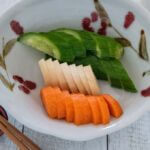
My Miso Pickled Vegetables (Vegetable Misozuke) are slightly different from most Misozuke recipes you might know of. The traditional miso pickling base is made of miso with a small amount of mirin. But my marinade contains a substantial amount of yoghurt which gives a milder saltiness to the pickled vegetables.
I did not include Meal Ideas today because today's dish can go with almost anything as a side dish, or even nibbles.
- 1 cucumber (about 140g/4.9oz)
- 80g/2.8oz daikon (white radish)
- 70g/2.5oz carrot
- 3 tbsp miso (note 2)
- 4 tbsp Greek yoghurt (note 3)
-
Trim both ends of the cucumber.
-
Halve the daikon and carrot vertically to make half-cylindrical shapes.
-
Mix the Misodoko ingredients well in a bowl, until lump free.
-
Put the misodoko in a ziplock bag.
-
Put the vegetables in the bag and massage gently, ensuring that all the vegetable pieces are coated in the misodoko.
-
Remove the air inside the bag as much as possible, then seal it.
-
Leave the bag in the fridge for at least 24 hours, up to 3 days (note 5).
-
Remove the vegetables from the bag, scraping off the misodoko as much as possible.
-
Rinse off the miso around the vegetables, pat dry, then slice them into 5-7mm/3⁄16-¼" thick pieces.
1. The size/quantity of each vegetable can vary. As long as all the vegetables can be all coated in the misodoko, you can pickle any vegetables in different quantities.
If you are pickling vegetables that are usually cooked to eat, e.g., pumpkin, burdock, you should blanch them before pickling.
2. I used brown miso, but you can use aka (red) miso or shiro (white) miso. In the case of shiro miso, use normal salty miso, not sweet miso such as Saikyo miso.
3. I used Greek yoghurt because it is less watery than natural yoghurt. Since the miso is quite a thick paste, you can use natural yoghurt if you prefer.
4. The misodoko can be reused one more time within a few days. After the second pickling, misodoko becomes watery.
Instead of vegetables, you can marinate sliced meat or fish for the second round, if you like.
The leftover misodoko can be used to make miso soup. Alternatively, adjust the saltiness of the misodoko by adding dashi stock, bring it to a boil, then use it as a dipping sauce for hot pot dish or noodles.
5. The longer you pickle the vegetables, the saltier they become.
6. Nutrition per serving. It is assumed that 1/4 of the marinade is absorbed into the vegetables.
serving: 79g calories: 25kcal fat: 0.4g (0%) saturated fat: 0.1g (0%) trans fat: 0.0g polyunsaturated fat: 0.1g monounsaturated fat: 0.1g cholesterol: 0.2mg (0%) sodium: 138mg (6%) carbohydrates: 4.8g (2%) dietary fibre: 1.2g (4%) sugar: 2.4g protein: 1.1g vitamin D: 0% calcium: 25mg (2% iron: 0.3mg (2% potassium: 168mg (4%)